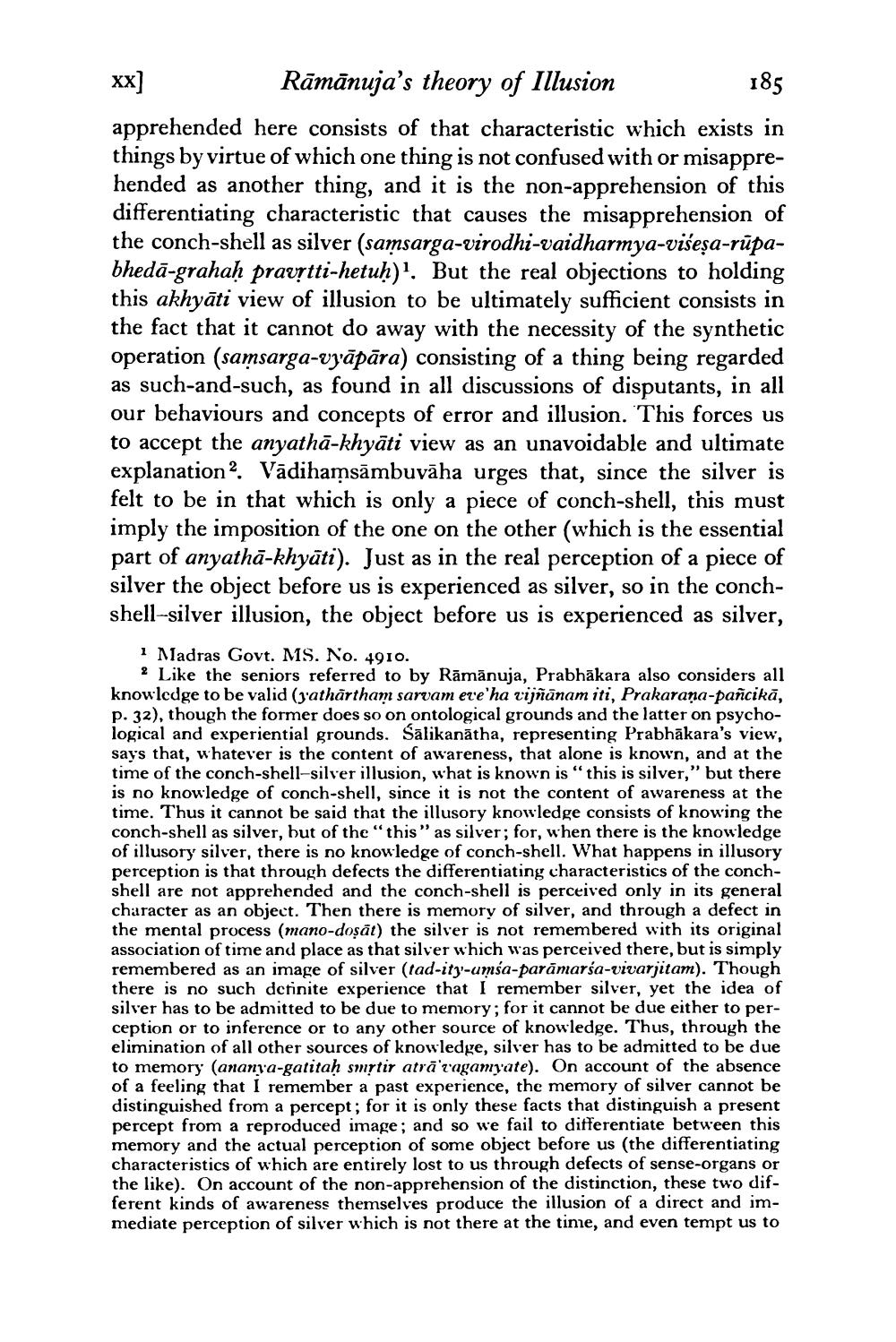________________
185
Rāmānuja's theory of Illusion apprehended here consists of that characteristic which exists in things by virtue of which one thing is not confused with or misapprehended as another thing, and it is the non-apprehension of this differentiating characteristic that causes the misapprehension of the conch-shell as silver (samsarga-virodhi-vaidharmya-višeșa-rūpabhedā-grahaḥ pravstti-hetuḥ)". But the real objections to holding this akhyāti view of illusion to be ultimately sufficient consists in the fact that it cannot do away with the necessity of the synthetic operation (samsarga-vyāpāra) consisting of a thing being regarded as such-and-such, as found in all discussions of disputants, in all our behaviours and concepts of error and illusion. This forces us to accept the anyathā-khyāti view as an unavoidable and ultimate explanation?. Vādihamsāmbuyāha urges that, since the silver is felt to be in that which is only a piece of conch-shell, this must imply the imposition of the one on the other (which is the essential part of anyathā-khyāti). Just as in the real perception of a piece of silver the object before us is experienced as silver, so in the conchshell-silver illusion, the object before us is experienced as silver,
1 Madras Govt. MS. No. 4910.
2 Like the seniors referred to by Rāmānuja, Prabhākara also considers all knowledge to be valid (j'athārtham sarvam ere'ha vijñānam iti, Prakarana-pancikā, p. 32), though the former does so on ontological grounds and the latter on psychological and experiential grounds. Sālikanātha, representing Prabhākara's view, says that, whatever is the content of awareness, that alone is known, and at the time of the conch-shell-silver illusion, what is known is "this is silver," but there is no knowledge of conch-shell, since it is not the content of awareness at the time. Thus it cannot be said that the illusory knowledge consists of knowing the conch-shell as silver, but of the "this" as silver; for, when there is the knowledge of illusory silver, there is no knowledge of conch-shell. What happens in illusory perception is that through defects the differentiating characteristics of the conchshell are not apprehended and the conch-shell is perceived only in its general character as an object. Then there is memory of silver, and through a defect in the mental process (mano-dosat) the silver is not remembered with its original association of time and place as that silver which was perceived there, but is simply remembered as an image of silver (tad-it-umsa-paramarśa-vivarjitam). Though there is no such definite experience that I remember silver, yet the idea of silver has to be admitted to be due to memory; for it cannot be due either to perception or to inference or to any other source of knowledge. Thus, through the elimination of all other sources of knowledge, silver has to be admitted to be due to memory (ananya-gatitah smrtir atrā ragamy'ate). On account of the absence of a feeling that I remember a past experience, the memory of silver cannot be distinguished from a percept; for it is only these facts that distinguish a present percept from a reproduced image, and so we fail to differentiate between this memory and the actual perception of some object before us the differentiating characteristics of which are entirely lost to us through defects of sense-organs or the like). On account of the non-apprehension of the distinction, these two different kinds of awareness themselves produce the illusion of a direct and immediate perception of silver which is not there at the time, and even tempt us to




